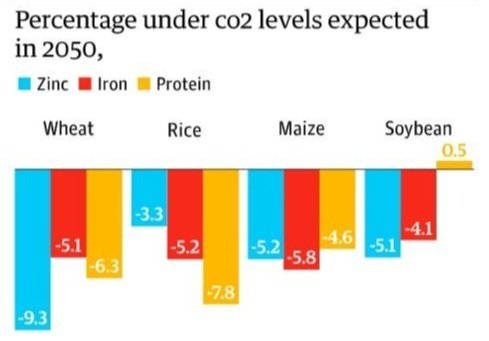The Silent Crisis: How Climate Change Can Exacerbate Barbados’ Non-communicable Disease Epidemic
Barbados, with its sun-soaked shores and vibrant culture, is a jewel in the Caribbean's crown. But beneath its postcard-perfect surface, a quiet crisis is unfolding, one that threatens the health and well-being of its people. This is not a crisis of nature's making, but rather a man-made specter: climate change. As the world grapples with the consequences of our planet's rising temperatures, the island nation of Barbados faces a unique battle. A battle not only for the preservation of its picturesque landscapes but for the very nutrition and health of its inhabitants.
In 2015, the Barbados Health of the Nation Survey sent shockwaves through the nation, laying bare the vulnerabilities of its adult population to non-communicable diseases (NCDs). These silent killers, from diabetes to cardiovascular diseases, now cast a long shadow over the island. According to a report by the Pan American Health Organization (PAHO), by 2019, they had become the leading causes of death in Barbados, with projections suggesting that they could account for a staggering 86.3% of all deaths by 2030.
While the government, recognizing the gravity of the situation, is encouraging its people to make healthier food choices, there's a cruel twist to this tale. Climate change, driven by rising carbon dioxide levels, is stealthily undermining the nutritional value of the very foods Barbadians are being urged to consume. The crisis extends beyond just the economy or ecology; it's a matter of survival for the vulnerable segments of the population, including the youth and the less fortunate
Speaking with Dr. James Hospedales, the founder, and Managing Director of EarthMedic and EarthNurse in Trinidad and Tobago, only three countries in the Caribbean: Guyana, Haiti, and Belize produce more than 50% of their food. The others rely heavily on imports for staple foods such as rice and wheat. Rising carbon dioxide (CO2) levels due to human activities are impacting plants and crops, interfering with their metabolic processes. Research at the Planetary Health Alliance of the Harvard Chan School showed that crops such as corn, wheat, and soy lost around 5% of their iron, 8% of their protein, and up to 10% of their zinc when grown in replicated 2050 conditions where CO2 levels are projected to be higher. These minerals are important for human health. For example, zinc aids in the functioning of the immune system, and iron is needed for hemoglobin formation.
Studies indicated that the increase in carbon dioxide levels reduced the zinc, iron, and protein content in crops that are staples globally. (Courtesy of Nature)
The price of locally grown food is also rising, as farmers will be forced to incorporate extra resources and damages caused by climate change effects into the cost. These include tropical storms and hurricanes which bring strong winds and heavy rains, but also heatwaves and drought, which affected the island throughout August and September severely impacting agricultural yields and leading to increased production costs.
Dr. Hospedales said the rise in prices will affect lower-income families who already have a difficult time purchasing healthy foods and noted that this dynamic has the potential to further exacerbate the NCD epidemic as the ones who are unable to afford healthier foods will be forced to settle for unhealthy options. Young children growing up in low-income households therefore are unable to get the sufficient nutrients required to combat diseases and can even affect their ability to focus in school.
Studies also show that nutrition availability from seafood also stands to be affected due to climate change as fisheries catch decreases. Warmer waters are causing fish species to shift migration patterns and coral reefs are bleaching severely, which in turn limits the available fish stocks. Fish is commonly listed as a food to combat NCDs as it protects against the risks of type II diabetes and coronary heart disease.
When asked about possible solutions to these issues, Hospedales suggested planting native crops that were well-suited to the climate such as sapodilla and peach palms. These crops require less tending to and grow without many resources being poured into them. The Caribbean Agricultural Research and Development Institute (CARDI) has played a role in educating farmers in the Caribbean region on how to handle the effects of climate change and which crops are resilient to intense rainfall or longer dry seasons. Dr. Hospedales listed eddoes and dasheen as crops that can handle flooding and cassava for long drought periods.
The island suffered heavy flooding in 2011, and many farmers incurred great losses due to flooded fields and damaged crops. (courtesy of watchers.news)
It is also important to ensure that the island is equipped with the technology to handle the changing weather patterns being experienced. Barbados partnered with the Food and Agriculture Organization of the United Nations (FAO) to increase climate-resilient farming practices and infrastructure to the agricultural industry. Under the ‘Addressing the Water-Energy-Food Nexus’ subproject of the “Mexico - CARICOM - FAO Initiative Cooperation for Adaptation and Resilience to Climate Change in the Caribbean.”, farmers undertook training in ‘Farming Best Practices’. This included learning efficient irrigation practices, water resource management, and conservation agriculture methods. Farmers were also assisted with rainwater harvesters and solar-powered irrigation systems to make open field production more sustainable.
Barbados has limited arable land space. As such, measures need to be put in place to protect what is grown on the island. The effects of climate change such as intense heat or strong storms and hurricanes are all factors which need to be considered. (Courtesy of Ulises Icardi)
Though climate resilience in the agricultural sector is an aspect that has been heavily considered and implemented in the Barbados government’s plans through technological and infrastructural improvements, the effect of CO2 on the nutritional value of the local crops has yet to be considered and studied. In encouraging the population to consume healthier foods efforts need to be made to identify those that are not being negatively impacted by the rise in CO2 levels.
This story has been done through Climate Tracker's Climate Justice Fellowship in partnership with the Open Society Foundations.



